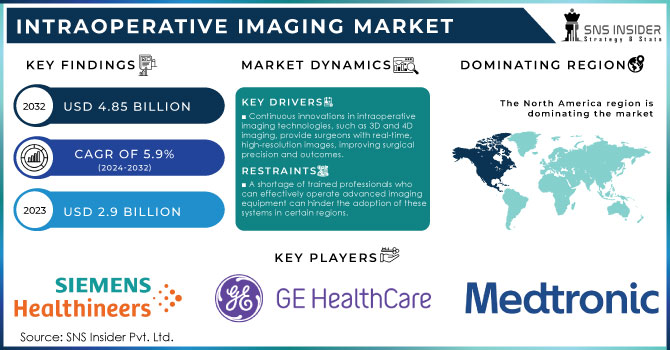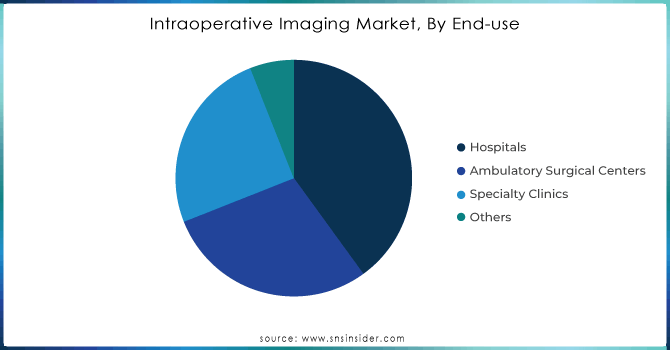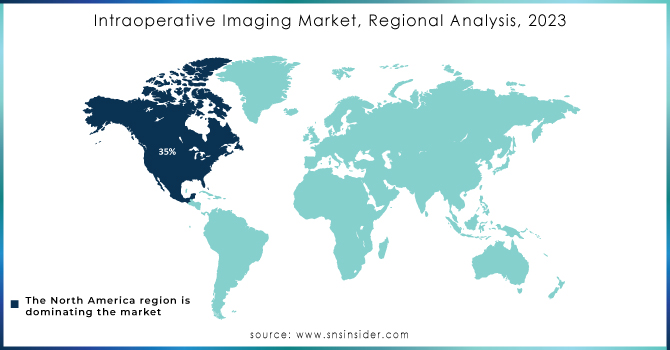Intraoperative Imaging Market Report Scope & Overview:

Get More Information on Intraoperative Imaging Market - Request Sample Report
The Intraoperative Imaging Market Size was valued at USD 2.9 Billion in 2023 and is expected to reach USD 4.85 Billion by 2032, growing at a CAGR of 5.9% over the forecast period 2024-2032.
The growth of the intraoperative imaging market is primarily attributed to increasing adoption rates for minimally invasive surgeries, technological advancements, and a growing prevalence of chronic diseases. As the global geriatric population rises sharply at least 1 in 6 people will be aged 60 or older by 2030, according to WHO so demand for better surgical care is increase. Intraoperative imaging tools such as Ultrasound, C-arm and iMRI are becoming essential in surgeries for neurology, orthopedics, and cardiology. The technologies improve precision, which provides better results and operating room efficiency. For instance, in March 2021, GE Healthcare received FDA approval for the OEC 3D surgical imaging system, which provides both 3D and 2D imaging, setting a new standard for spine and orthopedic procedures. Technological advances, including AI, 3D technology, and real-time imaging, are further fueling the market. In April 2023, GE Healthcare expanded the bkActiv system to aid in urology, colorectal, and pelvic surgeries. However, the high cost of these systems and increasing demand for refurbished devices may hinder market growth.
Companies, however, are venturing into mergers and acquisitions to reinforce their competencies in technology offerings while expanding regional interest. Although regulatory policies are necessary to protect the patient and stimulate innovation, they can sometimes be too costly which has an impact on costs device availability. Adoption is better in high-income countries such as U.S. and Japan but slower in developing regions due to lack of healthcare access, weak regulations and undeveloped infrastructure.
Market Dynamics
Drivers
-
Continuous innovations in intraoperative imaging technologies, such as 3D and 4D imaging, provide surgeons with real-time, high-resolution images, improving surgical precision and outcomes.
-
The growing incidence of cancer, cardiovascular diseases, and neurological disorders is boosting the adoption of intraoperative imaging to assist in complex surgeries for these conditions.
-
Intraoperative imaging systems are increasingly being integrated with surgical navigation platforms, providing real-time feedback during surgery, leading to enhanced procedural success rates.
-
Rising global healthcare spending and investments in advanced medical infrastructure, particularly in developed countries, are fueling the adoption of cutting-edge intraoperative imaging systems.
-
Intraoperative imaging allows for more precise surgical interventions, reducing the likelihood of re-operations and leading to faster patient recovery and better outcomes.
One of the most important reasons for improving the efficacy and precision in surgical procedures is being a significant driver due to advancements made in intraoperative imaging technology. 3D and 4D imaging, real-time MRI, intraoperative computer tomography these are technologies that provide surgeons with the ability to see exactly where they are working which means more accurate surgery and better patient outcomes. These advances make possible for example better navigation support in neurosurgery, spinal surgery and tumor resection in oncological surgery. For instance, 3D imaging systems allow surgeons colour corrected images of tissues and organs which help the surgeons in performing minimally invasive surgeries with high precision. A 2023 report from the American College of Surgeons states that intraoperative imaging during minimally invasive surgeries has increased by 15% in the last five years, marking an uptick towards technology-enabled procedures.
Another important technology is Intraoperative MRI (iMRI) In 2022, studies were published demonstrating that the rate of complete tumour removal was increased by up to an absolute value of 30% in surgeries with this imaging over those performed without it. It has the unique ability to provide surgeons with a real-time assessment of margins and extent of resection while the patient is still in surgery, allowing for greater certainty that all tumor areas have been identified resulting in avoiding follow-up surgeries. In addition, systems are being combined with AI to deliver a more sophisticated imaging solution for real-time decision making.
Restraints
-
The substantial capital investment required for the procurement and installation of intraoperative imaging devices is a significant barrier, particularly for small and mid-sized healthcare facilities.
-
A shortage of trained professionals who can effectively operate advanced imaging equipment can hinder the adoption of these systems in certain regions.
-
Complex and stringent regulatory approval processes for intraoperative imaging devices can delay product launches and restrict market entry, especially in emerging markets.
-
Inadequate healthcare infrastructure and limited financial resources in developing regions restrict access to advanced imaging systems, slowing market growth in these areas.
High cost of intraoperative imaging systems is a major restraint for the global market. These technologies, which include intraoperative MRI (iMRI) and CT scanners are high end systems, that require heavy capital investments for both acquisition as well as installation. Hospitals and surgical centers have a particularly difficult time justifying these costs, especially when resources are limited to begin with or the expected ROI (return on investment) is not immediately obvious. On top of this, costs for maintenance as well the necessity to have specially trained staff on-hand further ramp up expenses. The cost is especially prohibitive for smaller care facilities and clinics in an emerging market, which have less access to high-end medical equipment. This increasingly limits asset accessibility to high-budget hospitals and dedicated centers, thereby slowing the overall acceptance of these systems in global healthcare markets.
Segment Analysis
By Product
In 2023 the C-arm segment led the market and accounted more than 32% of the revenue share. The flexible nature of the system allows it to be positioned around a patient while providing optimal image angles that conform to patient comfort. Technological advancements are expected to drive further growth in this segment. for instance, in September 2023, Philips introduced the Zenition 30 and mobile C-arm series. The Zenition 30 offers customization and high image quality in a versatile system that streamlines clinical procedures Based on the established Zenition platform, which is synonymous with simplicity and seamless workflow enhancements, this system represents a cost-effective way to transform decision-time in many medical procedures.
The iMRI market is estimated to register a significant CAGR over the forecast period because of its ability to provide high-quality, real-time images. Thus, this technology makes surgeries more precise, especially in minimalist surgical tasks. It is particularly useful in neurosurgery as real-time intraoperative scans help surgeons visualise the anatomy and pathology, correct for brain shift and update neuronavigation data. Also used in surgical oncology, radiation oncology and ophthalmological areas among others, iMRI is an important tool for improving precise surgery and patient prognosis. The increased need for these advanced imaging systems fits well with global healthcare targets to enhance surgical precision and patient safety.
By Application
The neurosurgery segment also accounted for the largest share of revenue in 2023, with a share of around 29%, due to an increasing prevalence neurological disorder such as epilepsy, stroke, Parkinson's disease, migraines and more headache types, brain tumors multiple sclerosis; Alzheimer's Disease cadre. Epilepsy also appears to be on the rise, with almost 50 million people affected globally in 2023 as estimated by a WHO report from February 2023, suggesting significant increases in the global burden of neurological diseases. Intraoperative imaging has powerful implications on neurosurgery, and it allows surgeons to perform operations with more precision. This minimizes additional procedures and patient transfers in and out of the operating room, reducing risk.
The orthopedic surgery is expected to progress at CAGR of 7.6% throughout the forecast period principally owing rise in number of road traffic accidents. The WHO estimates that the economic costs of road-traffic injuries cost countries 3% of their GDP. The application of intraoperative imaging systems is also likely to surge with mounting demand for orthopedic surgeries. These smart imaging technologies are of extreme value in guided surgeries to increase surgical precision and patient benefit by assisting real-time. Global health continues to push towards improved delivery of care and surgical outcomes in all orthopedic procedures.
By End-use
The hospital segment accounted for more than 40% of revenue and is expected to maintain its dominance throughout the forecast period. The growth of this market is largely due to the increasing adoption of advanced intraoperative imaging systems for improved patient outcomes. The advance technology is expected to offer major advancements in surgical care, especially for the treatment of patients with brain tumors by being able to provide imaging data during an operation.
The ambulatory surgical centers (ASCs) segment is expected to grow at the highest CAGR during 2024-2032 due to increasing penetration of advanced technologies in these centres. ASCs have numerous advantages, including greater affordability for patients and insurance providers since they do not require overnight stays, which helps reduce healthcare costs. Furthermore, ASCs are generally less likely to present an infection risk in comparison with hospitals due to their smaller size and substantially lesser patient volumes. By having relatively short wait time and a more efficient overall patient experience, patients too can take advantage of ASCs being the increasingly popular choice for certain outpatient procedures. These advantages contribute to the growing demand for intraoperative imaging technologies in ASCs as part of efforts to enhance care quality and efficiency.

Need any customization research on Intraoperative Imaging Market - Enquiry Now
Region Analysis
North America held the largest share of 35% in terms of revenue generation in 2023, due to presence major market players and their continuous efforts towards product development activities such as acquisitions & expansions for R&D purposes. These initiatives ensure the availability of authentic medical-grade imaging systems, promoting market growth. In April 2021, the U.S.-based company Activ Surgical received FDA clearance on its ActivSight Intraoperative Imaging Module used to increase surgical visualization of real-time intra-operative visual data helping improve patient outcomes and operating room safety. The U.S. market is expected to grow at the fastest CAGR during the forecast period, due to a higher rate of chronic diseases and presence of major players with advanced imaging technologies that allow minimal invasive surgeries, which mean greater improvements in surgical efficiency. The region’s growth has been powered in part by increased collaborations between market leaders and technology companies. Through partnerships in the last two years, Ziehm Imaging GmbH has integrated with Carestream Health to distribute their c-arm -Ziehm Vision RFD C-Arms refreshing the access of high-end imaging system across different regions even after incorporation.
The Asia-Pacific region will grow at highest CAGR over (2024-2032) during forecast period due to developing healthcare infrastructure in emerging markets such as China and India along with increasing acceptance of advanced imaging equipment. High occurrence of chronic diseases coupled with massive geriatric population to drive the market revenue. The future, for example in Africa, is the need to provide more advanced medical imaging solutions.

Key Players
The major players are Canon Medical Systems Corporation, Siemens Healthcare GmbH, Ziehm Imaging GmbH, Medtronic plc, GE HealthCare, IMRIS, Brainlab AG, Koninklijke Philips N.V., NeuroLogica Corp, Shimadzu Corporation (Medical Systems). and other players
Recent Developments
-
September 2023, Strategic Collaboration for Research and Product Development with Mayo Clinic and GE HealthCare Together, the companies aim to reinvent radiology for patients and providers while also advancing new therapies.
-
In October 2023, IMRIS and Black Forest Medical Group introduced a new cranial stabilization system to the market. This cutting-edge system is specifically designed to support intraoperative MRI imaging during neurosurgical procedures.
-
New Flat-Panel Detector, November 2022 In May Search Ziehm Imaging GmbH demonstrated a new Indium Gallium Zinc Oxide (IGZO) flat panel detector at the Radiological Society of North America conference. It offers greater image quality with lower radiation exposure to patients for medical professionals.
| Report Attributes | Details |
|---|---|
| Market Size in 2023 | USD 2.9 Billion |
| Market Size by 2032 | USD 4.8 Billion |
| CAGR | CAGR of 5.9% From 2024 to 2032 |
| Base Year | 2023 |
| Forecast Period | 2024-2032 |
| Historical Data | 2020-2022 |
| Report Scope & Coverage | Market Size, Segments Analysis, Competitive Landscape, Regional Analysis, DROC & SWOT Analysis, Forecast Outlook |
| Key Segments | • By Product (C-arms, iCT, Intraoperative Ultrasound, X-ray, iMRI, Intraoperative Optical Imaging) • By Application (Neurosurgery, Trauma /Emergency Room Surgery, Oncology Surgery, Cardiovascular Surgery, Orthopedic Surgery, ENT Surgery, Others) • By End-use (Hospitals, Ambulatory Surgical Centers, Specialty Clinics, Others) |
| Regional Analysis/Coverage | North America (US, Canada, Mexico), Europe (Eastern Europe [Poland, Romania, Hungary, Turkey, Rest of Eastern Europe] Western Europe] Germany, France, UK, Italy, Spain, Netherlands, Switzerland, Austria, Rest of Western Europe]), Asia Pacific (China, India, Japan, South Korea, Vietnam, Singapore, Australia, Rest of Asia Pacific), Middle East & Africa (Middle East [UAE, Egypt, Saudi Arabia, Qatar, Rest of Middle East], Africa [Nigeria, South Africa, Rest of Africa], Latin America (Brazil, Argentina, Colombia, Rest of Latin America) |
| Company Profiles | Canon Medical Systems Corporation, Siemens Healthcare GmbH, Ziehm Imaging GmbH, Medtronic plc, GE HealthCare, IMRIS, Brainlab AG, Koninklijke Philips N.V., NeuroLogica Corp, Shimadzu Corporation (Medical Systems). |
| Key Drivers | • Continuous innovations in intraoperative imaging technologies, such as 3D and 4D imaging, provide surgeons with real-time, high-resolution images, improving surgical precision and outcomes. • The growing incidence of cancer, cardiovascular diseases, and neurological disorders is boosting the adoption of intraoperative imaging to assist in complex surgeries for these conditions. |
| RESTRAINTS | • The substantial capital investment required for the procurement and installation of intraoperative imaging devices is a significant barrier, particularly for small and mid-sized healthcare facilities. • A shortage of trained professionals who can effectively operate advanced imaging equipment can hinder the adoption of these systems in certain regions. |

